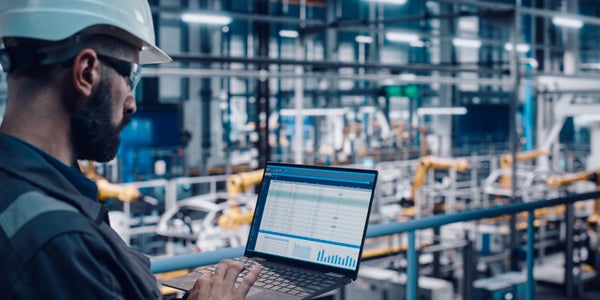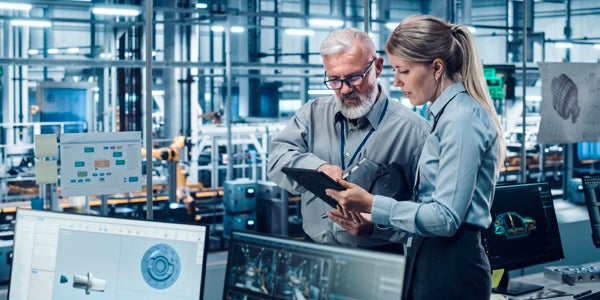Sustainability remains front and center in people’s minds today, and this is particularly true in the business sector. In this blog post, we discuss 10 sustainable business practices that can have a powerful impact. Read on to find out more.
Modern companies are increasingly turning to sustainable business practices for innovative and impactful solutions to ongoing challenges. With such high levels of environmental awareness among their consumer base, organizations of all shapes and sizes should take sustainability factors into consideration in order to remain competitive.
Sustainable business practices allow companies to leverage the social benefits of reducing their environmental footprint. They can employ industry 4.0 technology to digitize and automate tasks that minimize waste while compiling actionable data surrounding their operation's environmental impact. From tracking your water and energy consumption to reducing emissions and waste, sustainability is becoming critically important to incorporate in your long-term strategy.
Let’s explore 10 sustainable business practices your company should consider implementing—and how advancements in industry 4.0 will act as your guiding light.
Sustainability in the Workplace

1. Embracing the Hybrid Work Model
The pandemic forced many companies to pivot toward remote and hybrid work. Nobody had much of a plan in place, and the sudden shift turned into a work-life balance experiment on a massive scale.
The results are hard to dispute. According to the Harvard Business Review, 91% of remote workers want to continue hybrid and remote scheduling. Of them, 76% said their employers were willing to let them keep working remotely.
But shifting to remote and hybrid models isn’t enough to call your business sustainable. On a surface level, having fewer employees driving to and from the office sounds like it would cut extra emissions—and it does. But there are several intangibles to consider while your employees work from home.
What are their at-home energy consumption and waste production like? Is their home adequately insulated from the cold, and how much energy are they burning to heat it? Do they bring a reusable water bottle into the office but drink several plastic bottles at home?
Your employee’s home is their private sanctuary, so business leaders must tread carefully when “implementing” sustainability practices for their WFH employees. Begin by embedding sustainable techniques in company culture. Ensure you’re thinking beyond your CSR and ESG ratings to encourage employees. For example:
- Do you have initiatives in place to promote “green behavior” at home?
- Do your meeting policies include remote employees rather than defaulting to in-person?
- Are your company leaders promoting sustainability practices and commitments with their team members and remote staff?
You can further promote sustainable business practices by providing remote staff with supportive policies. Such methods include encouraging and supporting employees to embrace renewable energy in their homes and recycling drop-offs for old electronics and e-waste.
2. Zero Paper Waste
Thanks to industry 4.0, going paperless is now more realistic than ever before, yet plenty of companies still haven’t made the change. Some may not be aware of the benefits of zero-paper, while the thought of shifting practices intimidates others. There’s no need to feel overwhelmed—removing paper from your day-to-day practices is as easy as sending it through the shredder.

Going paperless does more than just reduce your waste. It’s the perfect example of increasing efficiency through sustainable business practices. According to Record Nations, in a non-paperless environment, an average employee can spend up to 40% of their day looking for physical paperwork in an old-fashioned filing system.
Converting your paper trail to a digital atmosphere gives you more control over your business workflows. By storing your essentials in the cloud, you can effortlessly search and find relevant documents for reference, legal, or other business reasons.
Going paperless is a great way to reduce operational costs as well. You don’t need files, folders, and space-occupying cabinets full of paperwork. You also eliminate the hassle of searching for lost documents, often popping up in the last place you look. By going paperless, you can focus more resources on improving your sustainable business practices with the time and money saved.
Aside from all the positive operational impacts, going paperless is an easy and effective way to help the environment. Converting to digital documents generates fewer physical copies and reduces paper consumption. Make sure you recycle the paper you no longer need after making digital copies.
Going paperless is as easy as:
- Using the Cloud to store documents via Google Drive, DropBox, or any similar program, if your security protocols allow
- Relying on eSignatures requested via email
- Creating digital receipts for auditing and expense tracking
- Converting your workflows to digital systems, including onboarding and contract agreements
3. Sustainable Business Travel Strategies

The pandemic opened our eyes to the sustainable benefits of remote and hybrid work; it also proved we could conduct in-person meetings and seminars online. Sustainable business practices regarding travel strategies speak for themselves.
As we all know, virtual meetings can save your company time and money, as well as reduce your impact on the environment. However, sometimes there are times when employees must travel for business reasons. When virtual meetings can’t suffice, you can still take several steps to embed sustainable business practices into their itinerary to reduce every team member’s impact on the environment.
For example, you can incentivize them to travel by train (or electric train) to tamp down on the CO2 emissions. Planes account for 2.5% of global CO2 emissions annually. If they must fly, it’s better to fly economy than business-class. The economy class fits as many people on the plane as possible.
You can also discourage short one- or two-day trips to reduce travel expenses and emissions. You can likely conduct those meetings virtually while limiting travel to essential three- or four-day trips.
Encourage electric or low-carbon vehicles if traveling employees must rent a car, or at the minimum, encourage carpooling or ridesharing if multiple associates are traveling to the same location. You can also book eco-friendly hotels in the area and encourage them to “eat green.” Supply them with reusable water bottles and discourage take-out.
4. Instilling Sustainable Values In Employees
Your sustainable business practices must go beyond pledge initiatives. Recycling plans and green travel benefits are great, but how is your company embedding sustainability in its culture? To achieve your goals, you must encourage green lifestyles in the workplace and ingrain those values in your employees.
Jeana Wirtenberg, CEO of Transitioning to Green—a management-consulting firm helping companies embed sustainability into their operations—leans on friendly competition to promote sustainable practices.
Speaking with Business Insider, she expressed how fostering environmentally conscious activities provides more interactive fun for employees. Companies can lean into their young workforces to create games and rewards surrounding sustainable practices. With Transition to Green, Wirtenberg rolls out activities and simulations to help people calculate their carbon footprint.
Companies coming out on top in the sustainability battle create conditions for their stakeholders and employees to own sustainability. It’s not someone else's job; it’s their own. According to SHRM, employees with active input in their company’s sustainable business practices are more likely to stay with that company in hope of recognizing those goals.
Your company’s ability to meet its sustainability goals boils down to employee engagement. It can be difficult for individuals to feel like they’re contributing when the overall goal is to, for example, “reduce emissions by 10%.” Dan from accounting or Sarah from marketing may not feel like their behavior is making a dent.
Find ways to bring corporate goals down to the individual level. You may recruit your most eco-friendly employees to role-play situations regarding sustainable strategies. Then, you can display those scenarios at your next staff meeting or in a company newsletter. In that same newsletter, you could publish a column highlighting a different employee in each issue and discussing their sustainable contributions. A “Sustainability Tips & Tricks” list can also help.
5. Green Web Hosting Services

People often overlook their web-hosting service when examining their carbon footprint. It’s a website. It doesn’t produce waste, and it doesn’t run on gasoline. How can it impact the environment?
True, your website isn’t producing waste—but the hosting service that keeps your site running 24/7 might be.
The equipment required to run hosting platforms consumes lots of power. Think about those massive data centers and all the energy they use daily. Between keeping the hardware up and running and maintaining temperatures in the server rooms, unsustainable data centers burn through energy like kindling. Thanks to green web hosting, that can change.
In short, green web hosting is an environmentally friendly way to host websites. Data centers can lean on renewable energy alternatives like wind and solar to keep their facilities running around the clock. Some data centers may not have the space or money to generate their own energy. Instead, they can turn to Green Tags purchased from energy supplies to offset their carbon footprint.
It’s not hard to tell if your web host is green. They’ll tell you loudly and proudly, as green web hosting is their entire business model. Once you partner with them, they’ll often provide you with a “green badge” that you can display on your web pages, letting your customers know you plan to honor your sustainable business promises.
6. Eliminating “Phantom Power”
Before we dive into eliminating phantom power, let’s define it. Phantom power is when your devices consume passive electricity while idle or in standby mode. For example, your Alexa or Google Home is currently consuming phantom power, even when it’s not doing anything. The digital clock in the guestroom and the tiny red dot you see on your TV (even when it’s off) still consume phantom power.
While your home is probably full of phantom power sources, an office is perhaps worse with all of the sleeping computers, devices, and electrical outlets. And considering the fact that most offices are empty for hours each day, imagine how much energy gets wasted daily in workplaces.
Phantom power can generate costly utility expenses without you realizing it, but there are steps you can take to eliminate phantom power in the office. For example, you can invest in programs that automatically power down unnecessary sources of electricity during non-working hours. Programmable power strips also cut power to your devices when people are out of the office or on vacation.
You can also imprint these sustainable business practices on your remote staff by encouraging them to unplug their phantom power devices at night. They’ll appreciate the reduction in their electric bill and their positive impact on the environment.
Sustainability in Manufacturing and Production

7. Recycle, Recycle, Recycle
Recycling is “king” among the most sustainable business practices. It’s easy to implement, track, and improve while saving your company money on costly materials. When you recycle and repurpose old materials and byproducts, you single-handedly keep waste and excess garbage out of the environment. If your company falls behind on its recycling initiatives, you may miss several financial and social benefits.
Experts predict that, by 2050, some 3.4 billion metric tons of solid waste will be generated worldwide. That said, the market value of global waste recycling services is poised to increase in the coming years to combat this. Driven by consumer awareness, the recycling market is expected to reach a $90 billion valuation with a CAGR of 4.8% between 2021 and 2030.
Environmental benefits aside, consider how recycling initiatives can also boost your company’s bottom line.
Recycling companies will purchase your used materials and turn them back into raw materials. Not only are you reducing your carbon footprint; but you’re also monetizing what was otherwise garbage—a win-win for you and the environment.
Robust recycling programs also attract more environmentally conscious people to your company. Think about it: people who don’t care as much won’t stop buying from you because you like to recycle. However, people who do care may choose your company over a competitor because of your sustainable business practices.
Customers aside, sustainable practices are a great way to attract top talent to your company. Simply recycling and cutting back on solid waste is one of the easiest ways to display your dedication to new prospects. Green initiatives create the kind of culture that young, environmentally conscious people want to be part of.
While you'll pay for recycling services (perhaps a little more than general waste management), the intangible benefits can lead to higher profits. Make sure your employees know which items and materials they can recycle and which they can’t. You may also consider a compost pile for organic materials, which can help generate healthier soil in your community.
8. Biodegradable Packaging
Over the past decade, more and more brands have switched to biodegradable and eco-friendly packaging. By doing so, these companies are helping the environment stay clean and healthy—the less plastic, the better.
Data published in Cision found that younger generations (under 45) are willing to pay more for sustainable packaging. Furthermore, 57% of consumers were “less likely” to buy products in harmful packaging, and 44% said they’d refuse to purchase packaging they deemed harmful.
You'll ultimately damage your bottom line if you put off your customers with harmful packaging. The revenue boost can offset the cost even if sustainable packaging is more expensive. You’ll also cement your brand as one that cares about the environment, making eco-conscious customers more likely to choose you again.
Jenny Wassenaar, the Chief Sustainability Officer at Trivium Packaging, believes that “...transitioning to sustainable packaging is not only the right decision for the environment but also the right decision for any business." For example, metal packaging aligns perfectly with a circular economy. Once produced, metal lasts forever and can be recycled repeatedly without losing quality.
McKinsey data found that more than 50% of US consumers remain highly concerned with the environmental impact of packing in general. They want to see more recyclable packaging moving forward, including fiber-based substitutes.
According to the EPA, we discard 77.9 tons of packaging every year, accounting for 30% of total annual waste. With most of that packaging ending up in landfills, the move to sustainable, green packaging is more important than ever.
You don’t need to recycle plant-based materials. Even if they end up in a landfill, they’ll naturally decompose. Ideally, that material ends up in a compost pile where it can do so with the rest of your biodegradables.
9. Using Non-GMO Ingredients

The global population is growing, so the debate about how to feed, clothe, and shelter everybody is raging. We may have to revolutionize our agricultural means of production to curb our dependency on fossil fuels and harmful practices. Genetically modified organism (GMO) crops rose to prominence through the mid-90s—but is it time to turn our attention back toward organic growing?
National Geographic estimates that 65% of all processed foods in your local grocery store contain ingredients from GMO corn, canola, and soybeans. The number of people actively avoiding GMOs has tripled since 2007, with 46% saying they try not to eat them.
The Hartman Group—a leading international food and beverage market research company—found that one-third of consumers looked for “no GMO ingredients” labels when shopping for food and beverages.
Operators in the food and agriculture industries can lean on non-GMO techniques to run more sustainable businesses. Research shows that organic farms use 45% less energy and decrease their carbon emissions by 40%. With non-GMO options gaining such rapid popularity, the energy savings coupled with revenue earnings spells good news for your bottom line.
10. Using Renewable Materials in Manufacturing
The trends don’t lie—modern companies are pushing harder than ever to incorporate green initiatives into their manufacturing processes. They’ve discovered that “going green” is more than doing what’s best for the planet. It also supports a healthier bottom line by reducing costs and increasing access to natural resources. To create a sustainable, circular economy, we must replace the linear model for sourcing manufacturing materials with one that leverages renewable energy and reduces waste.
According to a Deloitte report, implementing sustainable manufacturing practices has several benefits. Manufacturers can leverage these strategies to reduce costs and waste, gain a competitive edge, and improve operational efficiency. A 2021 survey found that of 750 executives, almost half reported that their sustainable business practices boosted their corporate financial performance.
Thanks to industry 4.0 advances like AI and Internet of Things (IoT) tech, companies can easily integrate green manufacturing into their operations. It all boils down to how well your green initiatives optimize
lean manufacturing practices
Lean manufacturing is a collection of business strategies focused on eliminating non-value added activities—or waste—while still delivering quality products on time and minimizing cost. Of course, this all ties into sustainable packaging and recycling, showing how just one sustainable business practice alone isn’t enough to achieve your eco-friendly goals.
Sustainability and Technology—How It Affects Your Bottom Line

Sustainable business practices may sound good on paper. But implementing these strategies through industry 4.0 technology can significantly boost your bottom line and improve your brand perception with valued customers.
While doing your part to protect the environment is all well and good, you’re still trying to run a profitable business at the end of the day. Thankfully, modern technology gives you the best of both worlds.
A leading minerals company in Europe leveraged a digitally-enabled energy control tower fitted with a cloud platform to develop an end-to-end energy management solution with enhanced AI and data analytics. The results? The company reduced energy consumption by between 5 and 10% and put itself in a position to save between €8 million and €9 million a year.
In tandem with Bain & Company, the World Economic Forum surveyed 400 executives on the importance of digital strategies for sustainability. Of them, 40% believed digital technologies positively impacted their sustainability goals.
Digital technologies can track your sustainability progress using various data points to reduce greenhouse gas emissions while optimizing renewable resources. AI and IoT systems strive to create a more circular economy, one poised to take better care of the planet for years to come.
Implement Sustainability in Your Systems Today!
The systems are available, and the tools are at your disposal. Intertwining sustainable business practices with your company’s DNA fosters a network of eco-conscious employees, board members, and shareholders. Your consumers have spoken, and there’s increasingly negative impact to companies that use practices deemed harmful to the environment.
Implementing these changes will eventually boost your bottom line, but they won’t come without initial financial investment. Ideally, you’ll have trusted financial partners like Bank of Blue Valley, a division of HTLF Bank to lean on during this time.
Get in touch with Bank of Blue Valley, a division of HTLF Bank to speak with a commercial banker. Together, you can start your company’s journey towards a greener, more sustainable future.







